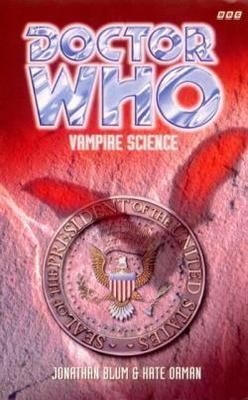
Vampire Science by Jonathan Blum and Kate Orman
In Brief: San Francisco. 1997. Vampires. Slaying.
Vampire Science is thankfully good, which is notable after the painful The Eight Doctors. As it was co-written by Kate Orman, who churned out some of the highlights of the New Adventures, the increase in quality in comparison to the prose of Terrance Dicks is hardly a surprise. However I found it to be less than satisfying, there's a gap at the novel's core.
This sense of something missing or rather a disjointedness mainly centred around the two lead characters, The Doctor and Sam. Nothing has quite gelled properly yet in the tales of the Eighth Doctor as he's a character that all of the authors so far haven't really been able to pin down. Of course, considering that Paul McGann only had around an hour of screen-time compared to the 12 televised stories of the 7th-Doctor it's hardly a surprise. The result though is that The Doctor, although technically less mysterious and scheming that his previous incarnation, feels much more distant. Over the course of the New Adventures the publishers were slowly able to move the character away from being an echo of Sylvester McCoy's performance into something with more depth. Unfortunately here they've not quite figured out where to go, except to have the "new" Doctor constantly be compared to the old in regards to differences in mannerisms and actions.
It was understandable in The Dying Days, but it's been 3 books now of different authors struggling with the character. It's becoming noticeable.
Another issue is Sam Jones. Thankfully she's much more fleshed out in Vampire Science than the light sketch of the character we got in the previous book, but again we've still no real sense of who she is and what makes her tick. We have the character-brief, that she's a blond skinny teenager and "right on!" activist with has a strong moral sense and sarcastic attitude, but no more. While there's some attempt to flesh her out through her having doubts of wanting to continue travelling with The Doctor, it doesn't feel right considering we've no understanding of her character. It's the book version of the problem with Mel, who on the show proper was just dropped into the action without any introduction. Although not nearly as annoying as she sounds, there still needs to be work done here.
So as a result Vampire Science ends up being a good book unfortunately marred by it's uncomfortable use of the lead characters.
Thankfully the authors are able to make up for the gap by having the rest be memorable and interesting, from medical-doctor Carolyn, who met The Doctor when young to 900-year-old head-vampire Joanna, who desperately wants to find a blood substitute so that her ilk can stop killing. The story itself isn't very plot-heavy, mainly centering around The Doctor (with the help of UNIT) trying to get to the bottom of recent vampire attacks and the resulting investigations. There are some decent quandaries-afoot as The Doctor and Joanna argue about the future of her kind, and an amusingly late-90s vibe as time is spent in a goth-club. But rather than just be overt horror this Vampire Science makes sure that the characters come first, particularly in how the react to what should be an impossibility.
I don't know the exact dates but Buffy must have been on TV by the time this book was written, although nowhere near as widely known as a couple of years later.
So overall the book is well-written and enjoyable but perhaps lacking in ambition. The regenerated series hasn't yet figured out how to go in a different direction the New Adventures, or even if it *can* do so. So the result, while by no means poor, feels like missed potential.
Oh, and there's no reason for the American Presidential Seal to be on the cover.
No comments:
Post a Comment